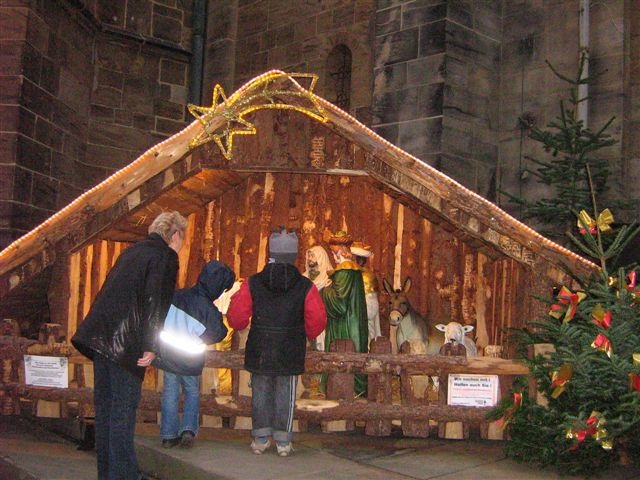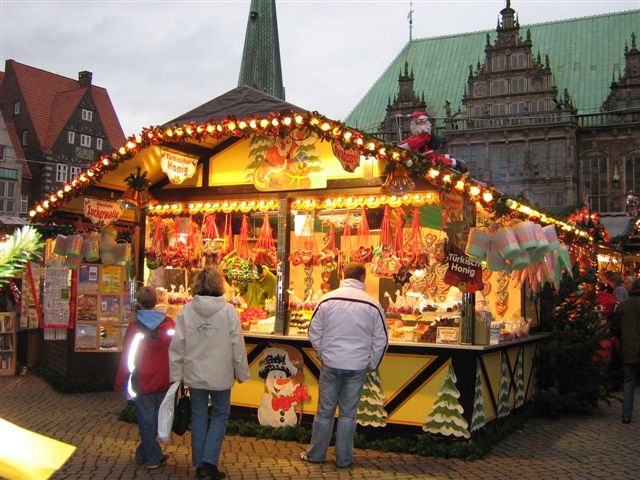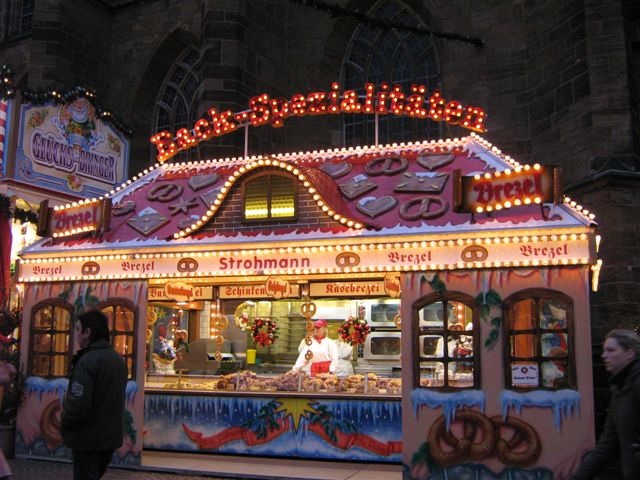Special Feature: Products Sally Recommends
Christmas Markets of Northern Germany
Froliche Weihnachten! Frohes Fest! (Merry Christmas! Happy Holidays!) At this festive time of year, our thoughts always turn to the Christmas markets in Germany. With more than 2,500 Christmas markets, Germany is bursting with holiday spirit. It seems as though Christmas was invented in Germany – at least the traditional ways we celebrate it, with the Christmas tree, decorations, special foods and gifts.
 The Christmas market is one of the best German holiday traditions, dating back to 1393. Little wooden huts decorated with twinkling lights offer an amazing variety of food, drink, decorations and gifts. Just wandering through the market will put you in the holiday spirit. You can enjoy the aroma of roasted almonds while sipping on glühwein (hot mulled wine), stop for a wurst (sausage) or some roasted chestnuts when hunger strikes, and browse to your heart’s content at booths filled with gingerbread cookies, candied apples, wooden nutcrackers, Christmas pyramids, Nativity scenes, hand-painted blown glass ornaments, wooden toys, candles and much more.
The Christmas market is one of the best German holiday traditions, dating back to 1393. Little wooden huts decorated with twinkling lights offer an amazing variety of food, drink, decorations and gifts. Just wandering through the market will put you in the holiday spirit. You can enjoy the aroma of roasted almonds while sipping on glühwein (hot mulled wine), stop for a wurst (sausage) or some roasted chestnuts when hunger strikes, and browse to your heart’s content at booths filled with gingerbread cookies, candied apples, wooden nutcrackers, Christmas pyramids, Nativity scenes, hand-painted blown glass ornaments, wooden toys, candles and much more.
For the kids, there is usually a carousel and a few games or rides, plus a non-alcoholic version of glühwein called kinderpunsch. There is always a Nativity scene somewhere within the market setting.
Christmas markets usually start before the first weekend of Advent (usually around the end of November) and continue until Christmas Eve. Some do not end until Epiphany, or January 6. In small towns, the markets might be open only on weekends.
We recently enjoyed the Weihnachtsmärkte, or Christmas markets, of northern Germany, also called Christkindlmärkte or Kristkindlmärkte. We have long been fans of the markets in Dresden, Berlin, Nuremburg, Regensburg, Munich, Würzburg and other cities, but we were smitten with their northern counterparts.
Loving it in Lübeck
In the Hanseatic town of Lübeck, only a few miles from the Baltic Sea, we had five markets from which to choose. Our favorite was the artisanal arts and crafts market in the Holy Spirit Hospice, itself a historic site worthy of a visit. This fair has been organized for more than 30 years by the Frau und Kultur (Women and Culture) association, and today attracts 180 artists from Germany, Scandinavia and the Baltic States. Visitors browse through the chapel, long hall and arches of the historic 13th century complex, enjoying the sights, sounds and aromas of Christmas while they shop. The Heiligen-Geist-Hospital is one of the oldest European institutions for the ill and needy; in fact, part of the complex is still a retirement home for senior citizens.
A few blocks away, the 800-year-old St. Peter’s Church opens its doors to more than 50 artists from Northern Germany. Browse the traditional and contemporary wares on display on tables as you stroll through the festively decorated church, then take a refreshment break in the medieval courtyard.
Most Christmas markets are outdoors, however, and three are clustered in the heart of the historic quarter of Lübeck, a UNESCO World Heritage site. The main market, next to the town hall, boasts the usual assortment of food and beverage stands interspersed with booths filled with hand-carved decorations, glass ornaments, hand-knitted items, jewelry and more. Around the corner in the courtyard of the Church of St. Mary is the medieval market, which sports the look of the Middle Ages, with tents, costumed performers and vendors, and booths with liqueurs, handmade arrows, jewelry, natural decorations, wooden toys, mistletoe and more. On the far side of the church, kids enjoy the fairytale market, which features displays of fairytale characters based mostly on the Brothers Grimm. Carousels, kid-appropriate gifts and foods, and strolling musicians complete the scene.
While in Lübeck, be sure to visit the Niederegger marzipan company, which celebrated its 200th anniversary in 2006. At Christmas, the interior of the shop is turned into a marzipan bazaar filled with every sort of marzipan delicacy, in all shapes, sizes and flavors. Upstairs is a small museum about the history of marzipan. Take a break in the Niederegger Café, where you can enjoy a light lunch or sample one of the dozens of dessert creations displayed temptingly in the center of the dining room.
Beautiful Bremen
 The incredibly beautiful town square of Bremen, a UNESCO World Heritage town, is the site of an open-air market with 150 stalls scattered in front of the historical town hall, St. Peter’s Cathedral and the famous statue of Roland. A stroll down the Bottcherstrasse, the historic barrel makers’ street, or around the Schnoor, the oldest part of town, leads past enticing shops, restaurants and bars, all brimming over with Christmas sounds and aromas. Along the Schlachte promenade on the River Weser, there’s a medieval maritime market, complete with games of skill such as shooting a crossbow, and booths with fortune tellers and magic tricks as well as gifts, foods and drinks. Sinter Klaas, the Dutch version of Santa Claus, visits on a pirate ship.
The incredibly beautiful town square of Bremen, a UNESCO World Heritage town, is the site of an open-air market with 150 stalls scattered in front of the historical town hall, St. Peter’s Cathedral and the famous statue of Roland. A stroll down the Bottcherstrasse, the historic barrel makers’ street, or around the Schnoor, the oldest part of town, leads past enticing shops, restaurants and bars, all brimming over with Christmas sounds and aromas. Along the Schlachte promenade on the River Weser, there’s a medieval maritime market, complete with games of skill such as shooting a crossbow, and booths with fortune tellers and magic tricks as well as gifts, foods and drinks. Sinter Klaas, the Dutch version of Santa Claus, visits on a pirate ship.
The town symbol is the four animal musicians of Brothers Grimm fame. There are statues of the Bremer Stadtmusikanten (Bremen Town Musicians)-- the donkey, dog, cat and rooster – all around town. During Advent, don’t miss the outdoor theatre production of the famous fairytale, by costumed local actors. Even though it’s in German, it’s easy to follow the action.
Half-timbered Celle
The town of Celle is one of the most picturesque in Germany. With more than 500 authentic half-timbered houses, in styles dating from the 15th to the 17th century, Celle offers one picture-postcard view after another. Beautiful medieval facades surround the Christmas market in the heart of the historical old quarter. There’s a Christmas tree more than 30 feet tall, a towering Christmas pyramid, and some 50 stalls selling crafts, decorations, toys and treats. Even with a light rain drizzling down, the atmosphere was magical and we couldn’t stop wandering from booth to booth.
To warm us up on a wet and windy night, we tried Feuerzangenbowle, or “burnt wine,” a drink of red wine, sugar and rum that is flamed. There were booths selling this specialty at almost every market we visited. It is a bit more potent than gluhwein, and very popular.
Celle was also where we sampled North German moor lamb. The local sheep have been crossed with moor sheep from Corsica, for a meat that has a slight wild game taste from the heath where the sheep graze. It is a specialty of the Historicher Ratskeller Celle, the restaurant in the ratskeller (basement) of the town hall.
Hamburg, the shopping city
Hamburg, the largest of the cities we visited, boasts an abundance of Christmas markets, each with a definite flair and flavor. In the heart of the downtown shopping area, there is one Christmas market after another, within blocks of each other.
 One of the prettiest markets, designed by Roncalli’s Circus, is in front of the town hall. With attractive stalls, decorative “street” names, and wandering circus artists, this market offers candy, cookies, toys, crafts, jewelry, dolls – the list goes on and on. Santa Claus arrives several times a day on an aerial cable, with his sleigh and reindeer. Suspended below the sleigh is a cloud holding a young girl representing the Christmas angel.
One of the prettiest markets, designed by Roncalli’s Circus, is in front of the town hall. With attractive stalls, decorative “street” names, and wandering circus artists, this market offers candy, cookies, toys, crafts, jewelry, dolls – the list goes on and on. Santa Claus arrives several times a day on an aerial cable, with his sleigh and reindeer. Suspended below the sleigh is a cloud holding a young girl representing the Christmas angel.
Along the Binnenalster lake and the Jungfernsteig street, in the heart of Hamburg’s deluxe designer shopping area, lies the Winterzauber market. With its peaked white tents and upscale signage, this market exudes a classy atmosphere suited to its high-end address. There’s an ice bar, a skating rink, and boats moored alongside offering puppet theatre and cookie baking for the kids.
Along the main shopping street of Monckebergstrasse, there’s a market around St. Peter’s Church, another on the Gerhart-Hauptmann square, and another by the Jacobikirchhof. Each has a slightly different atmosphere and slightly different wares, but all share the festive atmosphere, wooden stalls, and variety of food and drink.
A traditional market with a Hanseatic flavor is found at the Gansemarket, close to the main shopping district. Tucked snugly into the small square, the market booths are uniformly decorated, and there are definite entrances to the market. It has a compact feel and a sense of style.
A few blocks away from the downtown area, a small market with a definite Finnish flavor sits on the small Fleetinsel, or island. Booths offering Finnish woolens, handicrafts, glögg, schnapps, grilled salmon, and other Finnish treats are scattered amid more traditional German-flavored booths.
The most unusual of all the Hamburg markets we visited is the irreverent one at St. Pauli, the center of Hamburg night life and home of the famous Reeperbahn, where the Beatles got their start. Although the area has been cleaned up considerably in recent years, it still sports topless shows, sex paraphernalia shops and a red light district. It also boasts several Broadway-type theatres, lots of restaurants and hordes of tourists. The Christmas market, called Santa Pauli, bills itself as “Hamburg’s horniest Christmas market.” The erotic theme is carried out with humorous Santa signs on tops of booths as well as with the items for sale in some of the stalls – erotic wood, sexy underwear, water pipes and body-piercing jewelry. There’s a snow sledding piste and lots of typical food and drink.
Gluhwein a must
Wandering through an outdoor Christmas market on a chilly December evening calls for a warming drink, and the options are varied. The most popular drink is glühwein, which is served throughout the country. It is usually made with red wine, but sometimes white wine is used.
It’s a welcome treat when your fingers and toes are getting numb from the cold, but you haven’t finished visiting all the market stalls. It not only warms the spirit, it also helps wash down roasted chestnuts, grilled sausages or potato pancakes – all popular market fare.
On long winter nights in the 18th and 19th centuries, it was customary to share a few glasses of hot spiced red wine, or punch, with friends. Mulled wine spread from the home into the streets, becoming a tradition at the Weihnachtsmärkt.
There are many ways to prepare mulled wine, or hot red wine punch. Today’s recipe is easy to prepare and is as delicious at home in front of the fireplace as at an outdoor Christmas market in Germany. Fröliche Weihnachten.
GLUHWEIN
(Mulled Wine)
1 bottle dry red table wine
4 to 5 tablespoons granulated sugar, or to taste
1 stick cinnamon, broken into pieces
10 to 15 whole cloves, or to taste
Peel of 1 lemon, cut in a continuous spiral strip
Freshly grated nutmeg (optional)
Combine wine, sugar, cinnamon, cloves and lemon peel in heavy-bottomed saucepan. Simmer at least 5 minutes before serving. Be careful to not let it come to a boil. (Tip: Mulled wine can be prepared in and served from a slow cooker.)
To serve, strain and pour into glasses or mugs. (Tip: Insert a metal spoon in the glass to disperse the heat and prevent the glass from cracking.) Top with freshly ground nutmeg, if desired.
Keep remaining wine warm over low heat. Be sure to remove the lemon peel, as it can become bitter.
Yield: 4 to 6 servings.
Non-alcoholic version, also called kinderpunsch or children’s punch: Pour one quart red grape juice into saucepan or slow cooker. Add about 1/4 cup honey (or to taste); 1 cinnamon stick, broken into pieces; 3 whole cloves; and the peels of half a lemon and half an orange. Heat, but do not boil. Strain into glasses and serve.
WHEN YOU GO …
To put you into the holiday mood on the way over, consider flying Lufthansa, the German airline (www.lufthansa.com). The cabins are decorated with green and gold wreaths, and special holiday food is served on some flights.
Once you’re there, a great way to get around is via train. The Deutsche Bahn (www.bahn.de), or German railways, are clean, punctual and easy to navigate. Eurail (www.raileurope.com) offers a variety of rail passes that are simple for visitors to use and eliminate the need to purchase tickets before each journey. There are national passes (for use in one country), regional passes (for use in two countries), select passes (valid for three, four or five adjoining countries) and the original Eurailpass (valid in 18 countries).
For general information about Germany and its Christmas markets, visit www.cometogermany.com. For information about each town mentioned in today’s article, visit their websites, Bremen, www.bremen-tourism.de; Celle, www.region-celle.de; Lubeck, www.luebeck-tourismus.de; Hamburg, www.hamburg-tourismus.de.
![]()
St. Louis-based Barbara Gibbs Ostmann has enjoyed many of the German Cristmas Markets.
Note: This information was accurate when it was published. Please be sure to confirm all rates and details directly with the businesses in question before making your plans.



